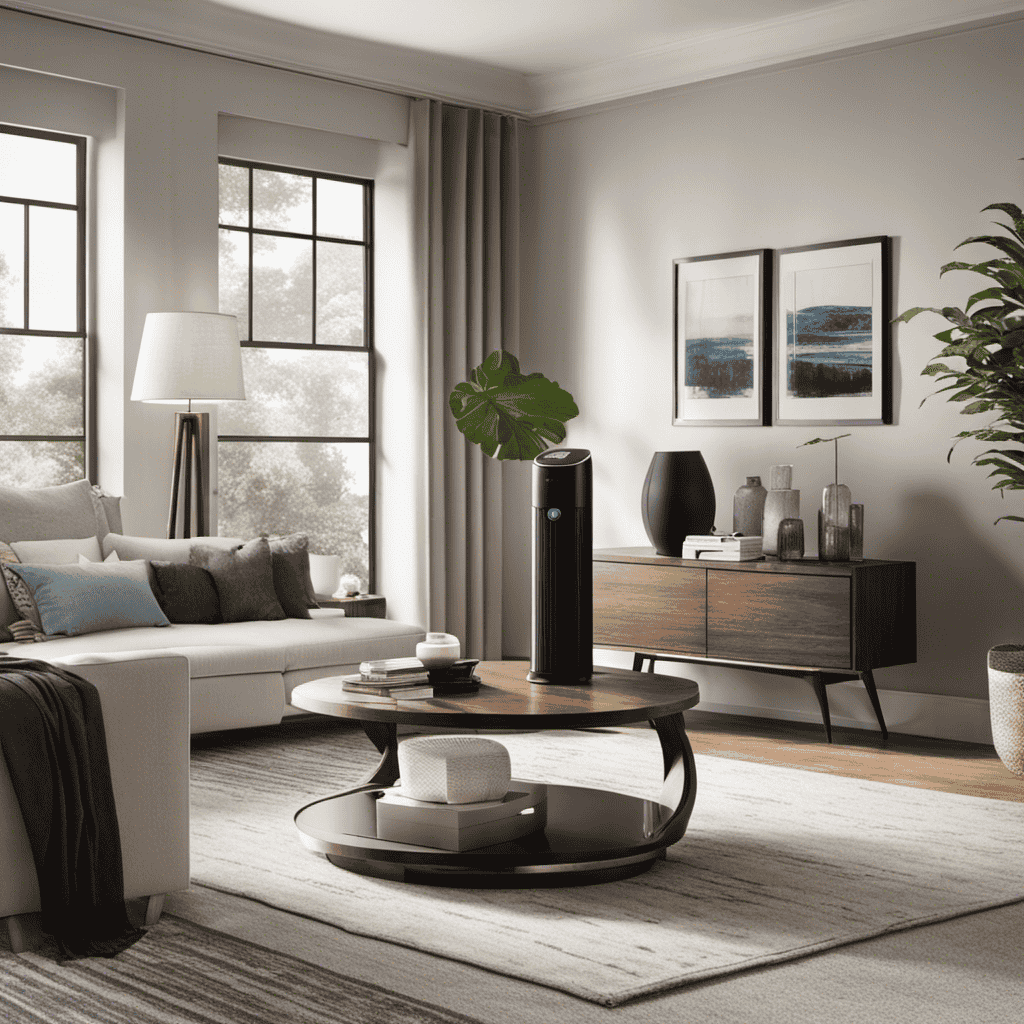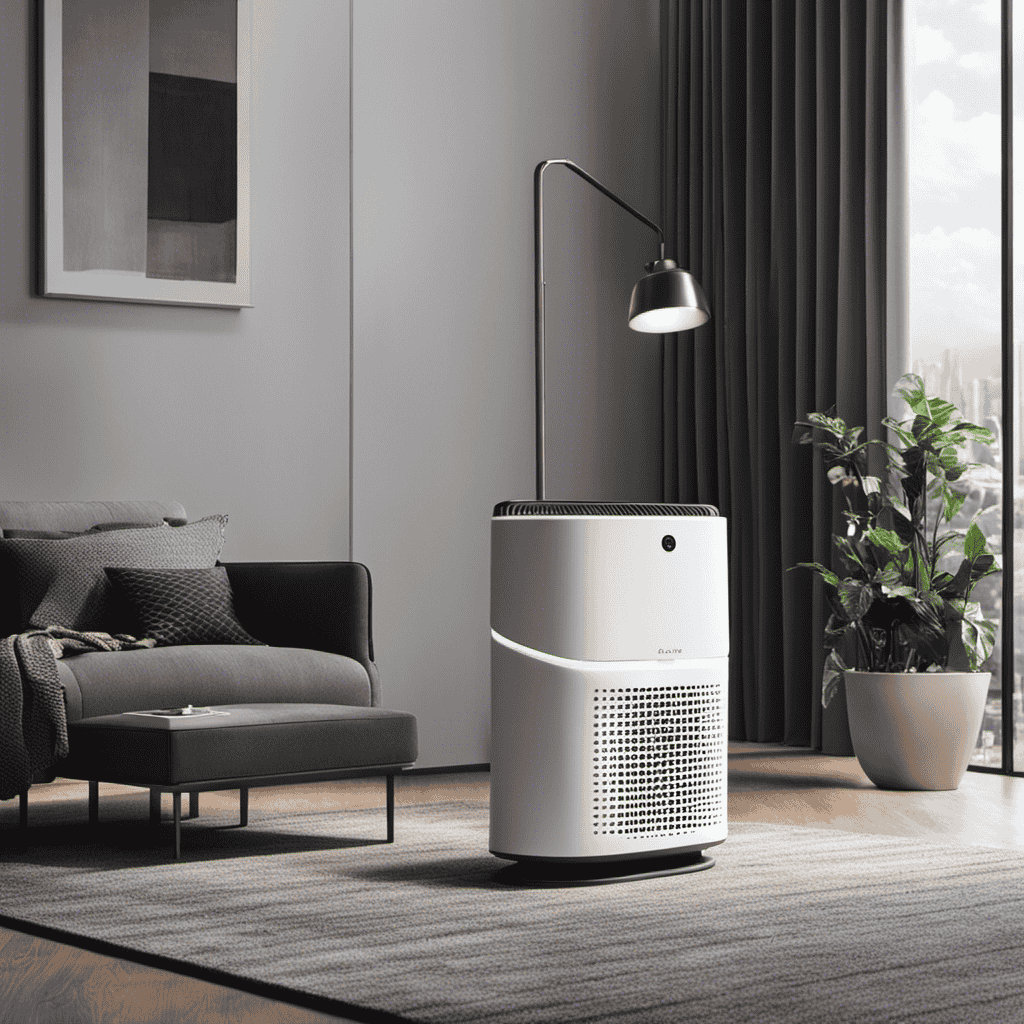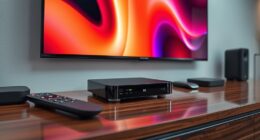I’ve embarked on a quest to enhance the air purity in my household, and one inquiry I faced was: what’s the ideal placement for an air purifier?
After conducting extensive research, I’ve discovered that the placement of an air purifier can greatly impact its effectiveness.
In this article, we’ll explore the benefits of positioning the purifier near the source of pollutants, considerations for placing it near windows or doors, and the importance of finding a central location in the room.
Let’s dive in and find the ideal spot for your air purifier.
Key Takeaways
- Placing an air purifier near the source of pollutants can improve indoor air quality and reduce allergy symptoms.
- When placing an air purifier near windows or doors, it is important to consider proximity to airflow, blocking the entry of contaminants, and maximizing air circulation for enhanced purification.
- Proximity to airflow is recommended, with a distance of three to six feet between the purifier and the airflow source, for maximum efficiency in cleaning the air and removing pollutants.
- Blocking pollutant sources, such as keeping windows and doors closed and using mats and rugs to trap particles, can help improve indoor air quality by preventing the entry of outdoor pollutants.
Benefits of Placing an Air Purifier Near the Source of Pollutants
Placing an air purifier near the source of pollutants can significantly improve indoor air quality. The proximity to pets and the effectiveness against allergens are two key benefits of this placement strategy.
Pets can be a major source of indoor air pollutants, such as pet dander and fur. By positioning the air purifier close to where the pets spend the most time, it can effectively capture and remove these allergens from the air.
Additionally, allergens like pollen, dust mites, and mold spores can accumulate in specific areas of the room. By placing the air purifier near these areas, it can efficiently target and eliminate these allergens, ensuring cleaner and healthier air.
Considering these benefits, it is important to also consider other factors when deciding where to place an air purifier, such as proximity to windows or doors.
Considerations for Placing an Air Purifier Near Windows or Doors
When it comes to placing an air purifier near windows or doors, there are several key points to consider.
First, proximity to airflow is crucial in order to effectively filter out pollutants entering from outside.
Second, strategically positioning the air purifier near potential pollutant sources, such as windows or doors, can help block the entry of contaminants into the room.
Lastly, maximizing air circulation by placing the purifier in a location that allows for optimal airflow throughout the space can greatly enhance its purifying capabilities.
Proximity to Airflow
To ensure optimal performance, you should position your air purifier near a source of airflow, such as an open window or a vent. Placing the air purifier in close proximity to a source of airflow can help maximize its efficiency in cleaning the air in your room.
The recommended distance between the air purifier and the source of airflow is typically around three to six feet. This allows the purifier to effectively capture and filter the air that is being circulated by the airflow source.
Blocking Pollutant Sources
Blocking pollutant sources can significantly improve the effectiveness of an air purifier in cleaning the air in your space. By preventing pollutants from entering the air, you can enhance the performance of your air purifier and improve indoor air quality. Here are a few ways you can block pollutant sources:
-
Keep windows and doors closed: This prevents outdoor pollutants, such as pollen and smog, from entering your space.
-
Use door mats and rugs: Placing mats and rugs at entrances can help trap dust, dirt, and other particles that may be brought in from outside.
-
Avoid smoking indoors: Smoking releases harmful chemicals and pollutants into the air which can be difficult to remove.
-
Regularly clean and vacuum: Dust, pet dander, and other allergens can accumulate in your space. Regular cleaning and vacuuming can help reduce their presence.
Maximizing Air Circulation
Improving air circulation in your space will help to distribute clean and fresh air more effectively throughout the room. Maximizing airflow is essential for maintaining a healthy indoor environment.
To achieve this, strategic placement of your air purifier is crucial. Firstly, position the purifier near the source of pollutants, such as a smoking area or a pet’s resting spot. This will ensure that the purifier captures the pollutants before they disperse throughout the room.
Additionally, placing the purifier in an area with good airflow, such as near a window or doorway, will help to circulate the purified air throughout the space. It is also recommended to avoid placing the purifier near obstacles, such as furniture or curtains, as these can obstruct the airflow.
The Importance of Positioning an Air Purifier at a Central Location in the Room
When it comes to positioning an air purifier, it is crucial to consider three key points: optimal air circulation, effective pollutant removal, and balanced coverage area.
Placing the air purifier at a central location in the room allows for better air circulation, ensuring that the purified air reaches every corner. This also helps in effectively removing pollutants from the air, as the purifier can capture and filter them more efficiently.
Additionally, positioning the purifier centrally ensures balanced coverage area, maximizing its effectiveness in providing clean and fresh air throughout the room.
Optimal Air Circulation
To ensure optimal air circulation, it’s important to consider the placement of your air purifier in the room. Maximizing airflow is crucial for the efficiency of the purifier. Here are some strategic placement tips to help you achieve the best results:
- Place the air purifier in an area with good air circulation, such as near a window or a doorway.
- Keep the purifier at least a few feet away from walls or furniture to allow for better air intake.
- Avoid placing the purifier in a corner or under a table, as this can restrict airflow.
- If possible, position the purifier in the center of the room to allow for equal distribution of clean air.
Effective Pollutant Removal
By strategically placing your air purifier in an area with good air circulation, you can effectively remove pollutants from the room. Air purifiers work by filtering the air and blocking airborne particles such as dust, pollen, and pet dander. When the air in a room circulates properly, the purifier can continuously remove these particles, minimizing allergens and improving air quality.
It is important to position the purifier away from obstructions like furniture or curtains that can impede air flow. Additionally, placing the purifier near sources of pollutants, such as cooking areas or pet beds, can help target specific problem areas. By considering these factors, you can ensure that your air purifier is optimally positioned to achieve the most effective pollutant removal and create a healthier environment for you and your family.
Now, let’s explore the concept of a balanced coverage area.
Balanced Coverage Area
Placing your purifier strategically ensures a balanced coverage area, optimizing pollutant removal. To maximize coverage and achieve optimal placement, consider the following:
-
Determine the size of your room: Measure the dimensions of the room to determine the appropriate purifier size. A larger room may require a more powerful purifier to effectively clean the air.
-
Identify pollutant sources: Take note of potential sources of pollutants, such as smoking areas or pet spaces. Position your purifier closer to these areas to capture the pollutants at their source.
-
Consider airflow patterns: Observe the natural airflow patterns in your room. Place the purifier in a location where it can effectively circulate clean air throughout the entire space.
-
Minimize obstructions: Avoid placing the purifier behind furniture or other obstructions that may hinder the airflow. Ensure that the purifier has a clear path to intake and release clean air.
How to Determine the Ideal Height for Placing an Air Purifier
The ideal height for placing an air purifier depends on the size of the room and the type of pollutants you are trying to remove. When determining the ideal positioning, it is important to consider that air purifiers work by pulling in air and filtering out contaminants. Placing the air purifier too low may lead to it pulling in more dust and allergens from the floor, while placing it too high may result in it missing pollutants near the ground.
Generally, it is recommended to place the air purifier at a height that allows for optimal air circulation and coverage. This usually means placing it at a level where it is able to effectively capture pollutants from the entire room.
As we move on to discuss the impact of furniture placement on air purifier effectiveness, it becomes clear that the positioning and height of the air purifier are crucial factors to consider.
The Impact of Furniture Placement on Air Purifier Effectiveness
When it comes to the effectiveness of an air purifier, the location in the room is crucial. Not only does the height of placement matter, but also the arrangement of furniture can impact its performance.
Here are a few points to consider:
-
Distance from walls: Placing the air purifier away from walls allows for better airflow and circulation, ensuring that the purifier can effectively clean the entire room.
-
Avoid blocking: Avoid placing furniture directly in front of the air purifier to prevent obstructing the airflow. This allows the purifier to capture more airborne pollutants.
-
Strategic placement: Positioning the air purifier in an area where it can draw in polluted air from the room and expel clean air back into the space is important for optimal performance.
-
Consider room layout: Take into account the overall furniture arrangement in the room. Placing the air purifier in a central location can help it reach all corners of the room more efficiently.
Placing an Air Purifier in Bedrooms for Better Sleep Quality
To maximize better sleep quality, you’ll want to position your air purifier strategically in the bedroom. Placing it in the right spot can help maximize airflow and reduce noise, creating a more peaceful sleeping environment. Here are some important considerations to keep in mind:
| Placement Option | Pros | Cons |
|---|---|---|
| Near the Bed | – Provides direct purification of the air you breathe while sleeping. – Helps to minimize airborne allergens and pollutants. | – May create noise disturbances if the air purifier is loud. – Requires extra space beside the bed. |
| Across the Room | – Distributes purified air more evenly throughout the bedroom. – Reduces noise impact if the air purifier is noisy. | – May not provide as direct filtration for those with specific allergies or sensitivities. – Requires a longer power cord or extension to reach the outlet. |
Should You Put an Air Purifier Near Electronics or Appliances
Placing an air purifier near electronics or appliances can help to reduce airborne particles and improve air quality in your bedroom. When considering where to position your air purifier, keep in mind the following factors:
-
Proximity to electronics: Placing the air purifier near electronics can help capture and filter out any dust or particles that may be emitted from these devices.
-
Distance from appliances: Appliances like refrigerators or air conditioners can release pollutants into the air. Positioning the air purifier nearby can help minimize their impact on air quality.
-
Airflow direction: Ensure that the air purifier is situated in a way that maximizes its efficiency by allowing for proper airflow circulation.
-
Energy consumption: Consider the energy consumption of both the air purifier and the electronics/appliances. Positioning the purifier strategically can help reduce overall energy consumption.
The Role of Air Circulation in Determining Air Purifier Placement
Positioning your air purifier in a way that allows for proper airflow circulation is crucial in determining its effectiveness.
To maximize efficiency, it is important to consider the direction of airflow. Ideally, the air purifier should be placed in a central location within the room, away from walls or furniture that could obstruct airflow. This allows for better distribution of purified air throughout the space.
Additionally, positioning the air purifier in an area where there is good air exchange, such as near a window or an open door, can help improve its performance. By ensuring that the airflow direction is unobstructed and the air purifier is strategically placed, you can enhance its ability to remove pollutants and improve indoor air quality.
Tips for Placing an Air Purifier in Open-Concept Spaces or Large Rooms
Now that we understand the importance of air circulation in determining air purifier placement, let’s discuss some tips for placing an air purifier in open-concept spaces or large rooms.
• Consider the size and capacity of the air purifier to ensure it can effectively cover the entire space.
• Place the air purifier in a central location to maximize filtration throughout the room.
• Avoid placing the air purifier near sources of noise, such as TVs or speakers, as this can disrupt your comfort and relaxation.
• Take into account the layout of the room and the flow of air to ensure optimal distribution of purified air.
Frequently Asked Questions
Can I Place an Air Purifier Near Plants or Flowers?
I wouldn’t place an air purifier near plants or flowers. While plants can help improve air quality, an air purifier may disrupt their natural processes. It’s best to keep them separate for optimal results.
Is It Safe to Put an Air Purifier Near a Fireplace or Wood-Burning Stove?
It’s important to consider fireplace safety when placing an air purifier near a wood-burning stove. The heat and smoke can damage the purifier’s filters and reduce its effectiveness in cleaning the air. Regular maintenance is crucial.
Should I Place an Air Purifier in a High or Low Traffic Area of the Room?
I would recommend placing the air purifier in a low traffic area of the room. This ensures that it can effectively filter the air without being obstructed or bumped into frequently.
Can I Put an Air Purifier on a Shelf or Table, or Does It Need to Be on the Floor?
I can put an air purifier on a shelf or table, it doesn’t have to be on the floor. But keep in mind that placing it on furniture may limit its air circulation and effectiveness.
Is It Recommended to Place an Air Purifier Near a Pet’s Bed or Litter Box?
Placing an air purifier near a pet’s bed or litter box is recommended to improve indoor air quality. However, for optimal effectiveness, it’s also important to consider placing one near the kitchen and in small rooms.
Conclusion
In conclusion, when deciding where to place an air purifier in a room, it is important to consider several factors.
Placing the purifier near the source of pollutants can be beneficial in targeting specific contaminants.
Positioning it at a central location ensures better air circulation throughout the room.
Interestingly, studies have shown that placing an air purifier in bedrooms can improve sleep quality by reducing airborne allergens.
Additionally, keeping the purifier away from electronics or appliances can prevent interference.
Overall, thoughtful placement of an air purifier can greatly enhance its effectiveness in providing clean and healthy indoor air.










